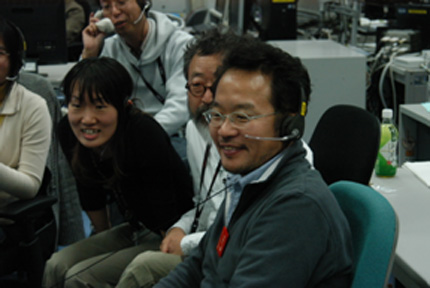This is an archive of information released in the past.
Disclaimer: It may contain broken links or outdated information. Some parts may not function in current web browsers.
*Visit https://humans-in-space.jaxa.jp/en/ for the latest information.

Experiment
- News
- Kibo Utilization Strategy
- Kibo Utilization Plan
- List of JAXA's Utilization Themes
- Experiment Facilities
- Space Environment Utilization
- Archive
CERISE In-flight Experiment Completed
* Dates and times are Japan Standard Time (JST)
CERISE*1, an experiment that investigates effects of microgravity on nematode C. elegans, which has been performed in the Cell Biology Experiment Facility (CBEF) onboard Kibo, was completed
*1 RNA interference and protein phosphorylation in space environment using the nematode Caenorhabditis elegans
(Principal Investigator: Atsushi Higashitani, Tohoku University, Sendai)
In-flight protocol of CERISEwas completed at 1:09 a.m. November 28, 2009.
The CERISEexperiment aims at clarifying mechanism of muscle weakening using a model specimen, nematode C. elegans, through two approaches; RNA interference (RNAi) that silences specific gene expression, and the mechanism of protein phosphorylation that acts as a switch for activating and deactivating protein activities in living organism.
RNA interference (RNAi) is noted as a useful technique for silencing specific gene expression with double-stranded RNA (dsRNA). RNAi is applied to not only basic life science research but also widely applied to eukaryotes (an organism whose cells contain cellular nucleus: for example animals, plants and fungi) as one of the methods of antiviral mechanism and reverse genetics.
The RNAi technique is expected to be applied in the future life science experiments in space, therefore, the CERISEteam tries to verify the effectiveness of the RNAi in space.
During the experiment, the nematodes were grown in the Cell Biology Experiment Facility (CBEF) in Kibo. Sample collections were conducted at the point the nematode larvae (the first generation) became adults, and at the point the second generation developed from eggs laid by the first generation became adults. Nematodes collected as samples from both points were frozen for recovery.
The sample recovery by the space shuttle is scheduled on February 2010. Using the returned samples, a post-flight analysis will be conducted. The genes and proteins will be extracted from both the samples (1. the first generation group of adults nematodes that has already developed their muscle on the ground, 2. the second generation group of nematodes that were developed from the eggs and grown in space) Using the genes and proteins of those sample groups, changes and differences in their activities will be examined.
During the experiment, environment control systems of the experiment facility were temporarily stopped due to system anomaly. The ground team is now evaluating whether this environment control trouble may have caused any impacts on the samples.
Comments from Principal Investigator, Professor Higashitani
This evening, I happened to watch the ISS and the space shuttle Atlantis, which was just separated and departed from the ISS, flying over the Tsukuba Space Center (TKSC). We, the CERISEteam members have visited the TKSC to monitor completion of the operations of in-flight experiment. We were excited when we saw video images downlinked to the ground; the nematodes looked as if they were dancing in the containers. We will be real busy when the samples are returned to the ground. We feel enthusiastic and tense when thinking about our upcoming post-flight analysis.

Principal Investigator (PI) Professor Atsushi Higashitani (center front) monitoring the completion of the experiment at the User Operations Area (UOA), TKSC
(Photo credit: JAXA)

C. elegance videoed by the microscope camera at the end of the experiment
(Photo credit: JAXA/Tohoku University)
*All times are Japan Standard Time (JST)
| Copyright 2007 Japan Aerospace Exploration Agency | Site Policy |